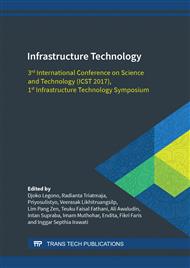p.42
p.48
p.55
p.64
p.70
p.78
p.89
p.98
p.106
Policy Analysis of Clean Water Supply System (CWSS) Development (Case Study of Kotamobagu’s CWSS)
Abstract:
CWSS in Kotamobagu has various problems such as, pipe water network that has not been operated optimally since its completion in 2012. The number of house connections was merely 424 out of 7,600 targeted until 2016. Other problems in Kotamobagu were related to the supply, backwash, insufficient electrical power supply, no water meter, reservoir leakage, and intake pipes leakage in Poyowa and Bilalang. This research aims to find the root of the problem in terms of Clean Water Supply System (CWSS)'s network system, organization, regulation, and management. The research focused on Poyowa Besar's CWSS and Bilalang-1's CWSS networks in Kotamobagu. The research methods included observation, survey, and policy analysis where respondents were required as sources of information. The respondents were from Sia's and Pontodon's CWSS that represented 162 house connections. Additional respondents representing 30 house connections were selected randomly at Poyowa Besar's and Bilalang-1's CWSS for comparison. The results indicated that the community, CWSS managers, and the Central Government support the existence of Kotamobagu CWSS management. The 30 house connections at Poyowa Besar's and Bilalang-1's CWSS have never been served with water, but the respondents positively hope that the matter will be solved in the near future. They were willing to keep waiting for the water network of Kotamobagu's CWSS. The root of the problem in the Poyowa Besar's and Bilalang-1's implementation was due primarily to a network system that was built by the Ministry of Public Works for the Municipal Government of Kotamobaguwas reportedly not in accordance with procurement regulation. There was disagreement between the Ministry of Public Works and Housing (MPWH) and the CWSS managers related to the items that have to be fulfilled for network infrastructure handover.
Info:
Periodical:
Pages:
70-77
Citation:
Online since:
May 2018
Authors:
Keywords:
Price:
Сopyright:
© 2018 Trans Tech Publications Ltd. All Rights Reserved
Share:
Citation:


